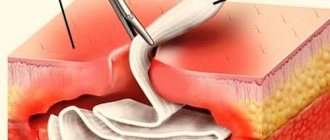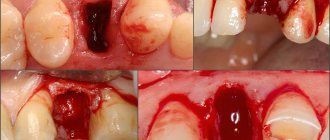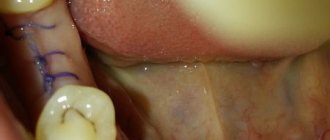Dental practice involves a large number of manipulations, accompanied by pain of varying severity. Fear of pain in the dentist's chair often forces the patient to refuse medical care until the last minute.
The most popular method of administering an anesthetic is infiltration with an average effect of up to 2 hours
Today, high-quality anesthesia is one of the criteria for which patients put forward the highest demands. People want to receive treatment in a comfortable environment, without unnecessary stress. There are several types of painkillers. Depending on the method of administration and the composition of the drug, anesthesia after dental treatment can last from a couple of hours to a day. The doctor chooses an option based on the complexity of the upcoming intervention.
Types of anesthesia, how it is done
The dentist can use application, infiltration and conduction anesthesia. In each case there will be a different depth of impact. Accordingly, anesthesia after tooth extraction will weaken, depending on the location of exposure and the concentration of the drug.
- The application type of anesthetic is a solution or gel that is applied to the surface of the mucous membranes. The effect is on receptors in the mouth and peripheral nerve endings. This type of anesthesia is used to relieve pain before injections, as well as when removing children's baby teeth.
- Infiltration is a shallow injection that allows you to locally “freeze” the peripheral nerves. This is the option most often used for dental treatment, extractions and simple surgical interventions.
- The conduction type of anesthesia allows you to “turn off” nerve channels and trunks. When it is necessary to desensitize half of the jaw, this option is used. It is used for tooth extraction, surgical interventions, and severe inflammatory processes. The injection is performed closer to the temporomandibular joint, in the branch of the trigeminal nerve.
Anesthetic for applications - a solution or gel applied to the mucous membranes
In complex cases, when the patient is treated using sedation with analgesia or general anesthesia, the anesthesiologist is responsible for deactivating the effects of the drugs. In this case, there is an effect on the central nervous system, suppressing not only the patient’s consciousness, but also all reflexes. General anesthesia after tooth extraction is completely removed within 24 hours.
After such manipulations, the patient is transferred to intensive care, where he is under the supervision of specialists.
It hurts to open your mouth after dental treatment
It happens that after dental treatment we do not receive the desired relief due to complications that have developed as a result of dental procedures.
Causes
There may be several reasons why it is painful for a patient to open his mouth after dental treatment:
- consequences of wearing braces
: after each correction, the doctor changes the pressure exerted by the arches on the dentition. It takes time to get used to it. However, if after a week the discomfort does not go away, you should additionally consult a doctor; - root canal filling
: moderate pain may be felt for several days, and this is considered normal. But if the pain does not go away longer and even worsens, it is necessary to take an x-ray and consult a doctor; - neuralgic complications
: can occur when a nerve is pinched or inflamed as a result of anesthesia, tooth extraction, incorrectly performed endodontic treatment, etc. A characteristic difference is that the pain manifests itself even at rest and tends to periodically intensify. It not only becomes painful for a person to open his mouth after dental treatment, but also absolutely everything in general. This kind of pain cannot be tolerated. The sooner the patient receives medical help, the better the treatment prognosis; - tissue injury during tooth extraction
. Extraction of a dental unit is considered a full-fledged operation, during which the surrounding tissues, the ligamentous apparatus that holds the dental unit in the socket, and the vessels that supply it are damaged. Often such manipulations are accompanied by the formation of large edema, and suppuration may develop. All this leads to the appearance of severe pain, which makes it painful not only to chew, but also to simply open your mouth. Therefore, if the pain increases over several days, you should additionally consult with your dentist; - dysfunction of the temporomandibular joint
can develop as a result of incorrectly performed dental prosthetics or overestimation of the filling over the bite; - Trismus of the jaw
(spasm of the masticatory muscles) can also be triggered by dental treatment.
Thus, moderate discomfort for several days after dental procedures is normal. But if it hurts to open your mouth after dental treatment after 3-7 days, consult your doctor. Perhaps this is a consequence of complications.
Read more:
- Complications after dental treatment
- Perforation of the maxillary sinus
How long does dental anesthesia last?
This is another important point. It is important for the patient to know that it will not hurt and to understand how long the dental anesthesia lasts. The last factor can be decisive for planning work functions for the rest of the day. Insensitivity increases the risk of injury to the tongue and mucous membranes, which is why dentists recommend refraining from eating and active speech. In the case of conduction anesthesia, problems with diction and swallowing may occur.
find out how long dental anesthesia lasts in your particular case from your attending physician. He selects 1 drug or combination and selects the dosage. The effectiveness of pain relief will depend on the sum of these criteria.
How many hours does it take for the tooth to be anesthetized depends on the drug and dosage
- Drugs with a short duration of analgesia give an effect for 30-60 minutes. For example, novocaine “works” for up to 1 hour, but in combination with adrenaline, the duration of action is extended to 90 minutes.
- The average duration of anesthesia for infiltration injection with lidocaine is 1.5-2 hours.
- Ultracaine - gives a high effect, lasts up to 5 hours, and Bupivacaine can freeze the injection area for up to 8 hours.
to predict exactly how long anesthesia will last for dental treatment for a particular patient only by taking into account all individual factors. Your doctor can guess the average exposure time, but it may vary.
Difficulty in achieving pulp anesthesia in mandibular teeth
Author: Unni Krishnan
Translation: Gavryushina Anna
Failure to obtain adequate pulpal anesthesia is the most common adverse outcome of local anesthesia in endodontics and is often associated with the administration of mandibular anesthesia. Although it goes without saying that absence of lip numbness is a clear sign of absence of pulpal anesthesia, absence of pulpal anesthesia may occur despite the presence of lip numbness, especially in mandibular posterior teeth with symptomatic irreversible pulpitis. Lack of pulpal anesthesia is often objectively verified as failure to obtain two consecutive readings of 80 using an electrical pulp tester or after prolonged application of a cold stimulus. However, every endodontist knows that the pulp can be sensitive even if these tests confirm complete anesthesia. Many studies have shown the inadequacy of mandibular anesthesia to provide sufficient pulpal anesthesia for restoration of about 50% of healthy anterior teeth, which should be anesthetized with mandibular anesthesia. The depth of pulpal anesthesia will decrease with pulpitis and other local factors.
Lack of lip numbness is a sign of improper anesthesia technique and is reported to occur in 5-23% of cases. Although lip numbness usually occurs 4–6 minutes after mandibular anesthesia, pulpal anesthesia in the mandibular first molar usually takes longer (up to 9 minutes). Lower central incisors may require more time (up to 19 minutes). In addition, 12–20% of patients may experience a slow onset of pulpal anesthesia, as determined by electrical pulp test readings occurring after 15 minutes. Thus, sufficient time must be allowed for pulpal anesthesia to develop before endodontic treatment begins. The slower onset in the anterior teeth must be taken into account when treating these teeth, although the latter can be anesthetized by vestibular infiltration.
Poor technique, failure to identify landmarks, insufficient dosage, and anatomical features such as bifurcation of the mandibular nerve canal are often cited as reasons for lack of lip numbness. Failure to identify three critical landmarks, namely the coronal notch, the pterygomaxillary suture, and the occlusal plane of the mandibular teeth, is the most common reason for failure of mandibular anesthesia. Many anxious patients open their mouth halfway and push their jaw forward. Surprisingly, one of the main reasons for failure of mandibular anesthesia is the identification of injection landmarks when the mouth is not fully open. Injections performed in this position of the jaw often result in the solution being injected ineffectively: distal and below the mandibular nerve. Perhaps the single most important addition to the administration of mandibular anesthesia is to ensure that patients open their mouths "as wide as they can" before receiving the injection. Ask pa
Why does pain occur after prosthetics?
After installation of the orthopedic structure, chewing proportions are gradually rebuilt. This does not mean that the prostheses were poorly manufactured and installed. In every possible case, the distribution of chewing pressure across the teeth changes. There is a so-called “optimization” for the new bite. The fact is that if a person has walked without teeth for a long time, then the dental system begins to distribute the load differently. Therefore, after installing a removable denture, unusual sensations, including irritation, occur while chewing food.
To make the use of prostheses as comfortable as possible, the doctor prescribes additional examinations for the patient to correct the design. After all, you cannot guess in advance and do everything exactly as nature intended - each case is unique and individual. To adjust a prosthesis, you must first use it “in everyday life.”
Instruction No. 1 (from 2 to 5 weeks after surgery).
Basic exercise to restore sensitivity / Do this exercise using a small brush (for example, a toothbrush or cosmetic brush) at least 3 times a day for 5 minutes each time (morning, afternoon and evening).
First you will need a mirror. 1. Alternately touch and stroke the entire surface of the face with the brush. 2. Then make a series of light touches at a relatively large distance from each other, first on one side of the face and then on the other. The frequency of movements with the brush should be as if you were trying to touch a piece of fabric. 3. As the exercise progresses, remember the place where you made the touches and then repeat the next series in a similar place, but on the other side of the face. 4. Be careful and go over the entire surface of the face (forehead, cheeks, chin, upper and lower lip). Don't get stuck in one place. Additional exercises to restore sensitivity / You can perform exercises to restore sensitivity an unlimited number of times a day. At the initial stage, it is important to look in the mirror during the exercise. If you don't have a brush, you can do this exercise with your fingertip. 1. Close your eyes and continue alternately touching and stroking your face with the brush. Tell yourself before you do this what will happen next: a series of touches or stroking. It is important to feel this difference. 2. You can ask someone to do this exercise for you. The first few times, the assistant first tells you what movement he is going to do: a stroke or a series of touches. Remember that your eyes are closed. The assistant continues to do the exercise and then stops telling what movements will follow, and you must determine them yourself. If you can do this with ease, this is a good sign. It is also important to weaken the force of the touches and make them closer to each other, which will complicate the task. 3. Remember to make a series of light touches both horizontally and vertically. If you have difficulty feeling touch even at a fairly large distance, do not despair. For most people, sensitivity returns slowly and you need to be patient. We remind you that the full return of sensitivity in some cases can take up to 12 months.
Instruction No. 2 (from 5 to 12 weeks after surgery)
Basic exercise to restore sensitivity / Do this exercise using a brush in the morning, afternoon and evening for 5-15 minutes each time. First, monitor your actions in the mirror. 1. Use light tapping on one side of the face and then on the other. 2. As you complete the exercise, remember where you tap. 3. As you begin the side-to-side exercise, start on one side of your face and tap to a similar area on the other side. For example, start at the base of the ear on one side and work your way through the upper lip area to the base of the ear on the other side. 4. When you do the exercise in the vertical direction, also go over the entire face from above and below. Start, for example, at the neck and work all the way up the side of the face to the forehead, and then back to the neck. You can also do the exercise from the infraorbital region down to the neck and back. 5. As you complete the exercise, note your sensations, whether there is a difference and what its magnitude is. 6. Be careful and do the exercise over the entire surface of the face (forehead, cheeks, chin, upper and lower lip). Don't get stuck in one place.
Additional exercises to restore sensitivity / You can perform exercises to restore sensitivity an unlimited number of times a day. At the initial stage, it is important to look in the mirror during the exercise. Also, if you don't have a brush, this exercise can be done with your fingertip. 1. Close your eyes. Before you start lightly tapping your face, tell yourself exactly how you will start doing it and in what direction. 2. If there is someone who can help you do this exercise, then the first few times the assistant says where he is going to start and in what direction he will proceed: from side to side or from bottom to top. Next, without opening your eyes, ask your assistant to continue the exercise without notifying the next places and direction of touch. If you can easily identify the differences, this is a good sign. 3. Remember to try every day to make the touches softer and closer and closer together to make the task more difficult. If you have difficulty feeling touch even at a fairly large distance, don’t worry. For most people, sensation returns slowly and you will need to be patient.
Causes of pain after dentures
All inflammatory processes are accompanied by pain, redness, swelling and dysfunction of the affected organ. However, each pathological process has its own symptoms and cause. For example:
- Incorrect or incomplete preparation of teeth for prosthetics. This means the lack of professional hygiene, root canal treatment, oral sanitation and treatment of chronic foci of infection and periodontal diseases.
- Errors in the choice of design, as well as its manufacture. Incorrect installation leads to the formation of too large gaps between the gum and the prosthesis, or vice versa - to its too tight fit. In the first case, there is a constant accumulation of food debris, inflammation, pain and an unpleasant odor. In the second - the formation of bedsores, with similar symptoms.
- Failure to comply with the rules of operation of the structure and oral hygiene, which entails complications in terms of breakage and damage to the dental structure, accumulation of hard and soft plaque, the development of periodontal diseases and carious processes with its complications.
- Allergy to prosthetic materials. Sometimes such an individual reaction occurs to the residual monomer of the base of removable structures.
Oral hygiene
Any of the above reasons leads to the development of complications, which are often accompanied by toothache after dentures . It can be:
- Caries and its complications – pulpitis, periodontitis, periostitis.
- Acute or aggravated forms of periodontitis.
- Prosthetic stomatitis.
- Mechanical injury to the soft tissues of the oral cavity due to dental structures.
How long does pain last after dental implant placement?
Let's consider the normal postoperative course of the condition.
1-5 day
. The pain may increase during the first few days, starting from the moment the anesthetic administered before implantation wears off. It can be aching, throbbing, and worsened by tilting the head. While this does not indicate a complication, this is the body’s natural response to intervention. As well as swelling of the tissues in the area of the implant.
5-10 day
. By the 5th day the pain subsides. The swelling subsides completely. The question remains for the patient: how much does the gum hurt after installing the implant, since it is still sensitive. By the 10th day, as a rule, everything goes away.
After 2-6 months
. There are times when everything goes fine, but after a few months or even a year a person complains that the tooth implant around it hurts. Possible reasons:
- loosening
of the plug, adaptation crown on the abutment. They rub the soft gum tissue. The situation is not critical. The dentist will adjust, carry out the necessary manipulations and you don’t have to worry about the safety of the implant;
implant rejection An unfavorable outcome of the entire implantation is unsuccessful osseointegration. The body did not accept the artificial tooth root. Fortunately, the rejection rate is close to 1%;- inflammatory
gum diseases. This is often due to poor hygiene and violation of the doctor’s postoperative recommendations; - injury
to the jaw nerve, then the jaw hurts after implantation.
If your gums, jaw, or ear hurt for more than 10 days after dental implantation, do not put off visiting the doctor who performed the operation. Early diagnosis and initiation of treatment will avoid complications. Calling after two weeks or more with such symptoms may delay treatment for a longer period.










